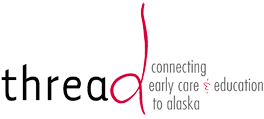Alaska Launches Learn & Grow
Statewide Quality Recognition and Improvement System (QRIS)
ANCHORAGE, AK—July 6, 2016—Alaska joins 43 other states in offering a statewide Quality Recognition and Improvement System (QRIS) for early care and learning programs. This new system is called Learn & Grow and is designed to foster the success of young children in our state. “This is a huge step forward for early childhood in Alaska,” stated Meghan Johnson, Director of Learn & Grow. “We have a tremendous opportunity to improve the quality of early care and learning and make a profound impact on young children. Research shows that when a child experiences high-quality early care and learning, they are better prepared for school, healthier, and more successful in life than children who experience lower quality care.”
During the last 13 years, Alaska has worked to move a QRIS forward. Three years ago, the Department of Health and Social Services, Division of Public Assistance, Child Care Program Office allocated funds to thread, Alaska’s Child Care Resource and Referral Network, to manage the development and implementation of Alaska’s QRIS. Ms. Johnson was hired as the Director of Learn & Grow and stakeholder groups and committees were assembled to help develop the current system. “Learn & Grow is a system built to recognize the quality practices child care programs are already engaged in, and provide supports for continuous quality improvement. “ said Health and Social Services Child Care Program Coordinator Christina Hulquist. “This system will benefit children, families, and early childhood educators, as well as lay the foundation for positively impacting the social and economic environment in Alaskan communities and the state as a whole.”
What is QRIS?
QRIS is a formal system that provides the framework for early care and learning programs to actively engage in continuous quality improvement. At the same time, it provides families a mechanism to gage the level of quality of individual programs when looking for care for their children. Learn & Grow also provides families, communities, and policy makers here in Alaska with an understanding of what quality early care and learning is and the impact it can have on children’s development and readiness to learn and succeed in life.
Three-quarters of the nation’s children between the ages of 3 and 5, and more than half of children aged 2 and under, spend time in some form of care outside of the home. Many of these children are cared for by relatives, but a large proportion—57 percent of children aged 3 to 5 and 20 percent of infants and toddlers—are in center-based care. We see similar numbers here in Alaska where 55 percent of children under the age of 6 and 42 percent of children 6–12 regularly receive care from someone other than a parent or guardian. The quality of care in early care and learning settings varies dramatically. Over the past decade, states have turned to voluntary QRIS programs as a way to close that gap and raise the overall level of quality.
As the states and the federal government increase investment in early care and learning, QRIS can also serve as an engine for states’ efforts to build early childhood systems. QRIS institutionalizes and sustains cooperation among early childhood stakeholders in government, as well as educators, researchers, and community leaders. In doing so, it can even promote communication and improve alignment between the early childhood and K-12 education systems.
How Learn & Grow Works
Participation in a QRIS is associated with improved levels of quality. The following are key elements of high-quality early care and learning programs as identified by research and professional standards:
- Use of assessments and curricula to design individualized learning opportunities for all children
- Small class sizes with low student to teacher ratios
- Safe and healthy learning environments
- Ongoing supports for early educators, including professional development, coaching, and technical assistance
- Meaningful family engagement
Learn & Grow utilizes a block system with five levels of quality. Programs will be evaluated on four quality standard areas within each level: Administration and Leadership; Staff Qualifications and Professionals Development; Relationships and Learning Environment; and Family Engagement. The block system requires an early care & learning program to achieve all of the quality requirements of a given level before receiving the level recognition. The five levels of quality build on the foundation of health and safety standards that govern licensed child care facilities in the state of Alaska.
The five levels of quality within Learn & Grow are:
- Level 1: Learning About Higher Quality (now available)
- Level 2: Moving Into Higher Quality (now available)
- Level 3: Committing to Higher Quality
- Level 4: Growing Into Higher Quality
- Level 5: Thriving In Higher Quality
Early care and learning programs will be able to advertise their participation in Learn & Grow. When families see a program is participating in Learn & Grow, they know the program is committed to continuous quality improvement activities and receiving the specialized training and resources needed to best prepare young children for success in life.
A Phased Approach
Learn & Grow has two phases of implementation. Phase I of Learn & Grow—launching July 1, 2016—is a voluntary statewide system available for State of Alaska and Municipality of Anchorage (MOA) Licensed Child Care Centers, Group Homes, and Homes. It includes the first two levels of quality.
Phase II of Learn & Grow will include quality standards across all five levels and will include specific quality standards for: Head Start/Early Head Start, State Pre-Kindergarten or School District Pre-Kindergarten, Military Child Care, and Licensed School-Age programs. As Learn & Grow advances and as funding allows, Level’s 3, 4 and 5 will become available for all early care & learning programs.

